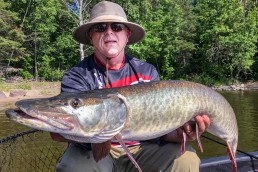How Many Casts Does It Take to Catch a Muskie?
SHARE THIS POST
When it comes to muskie fishing, Joe Bucher reminds us that you can go from zero to hero in a matter of seconds. It only takes one cast.
Muskies have long been called “the fish of 10,000 casts.” It’s the apex freshwater predator demanding the very best in skills, stamina and sheer effort. Yet, it is also a sportfish that can change your life in a split second. In a nutshell, no matter how poor your muskie fishing has been on any given trip, you’re literally one cast away from a home run.
For example, on a fruitless outing a few years back, I was into my third day with no muskies boated and almost no fish action of any kind, when my luck suddenly changed in an instant. My first spot stop after lunch, a thick weed bed in a sandy bay, was like a brand-new fishing trip with pike pouncing on my lipless crankbait on nearly every cast. Baitfish were everywhere, too, breaking the surface near sunbaked shallows inside the weed clumps. I could sense something had definitely changed, and a window of opportunity was at hand.
Moving along the shoreline terrain, the bottom substrate eventually transitioned from sand with weed clumps to rocks with a prominent point. Instinctively, I launched a long cast over the rock projection. Moments after my lure touched water, I began an aggressive retrieve, along with a rod lift to spurt the sinking vibrator quickly over the shallowest rocks without snagging up. As soon as the lure had cleared those shallow rocks, I backed off a touch on my retrieve and lowered my rod tip to allow the sinking lipless crankbait to descend along the tapering contour.
Abruptly, a solid bump interrupted the lure’s rhythmic vibe, instantly telling me I had slowed down a bit too much and the lipless crank had careened off a large boulder. Instinctively, I lifted upwards on my rod tip and aggressively increased retrieve speed to drive the lure up and over the big boulder. Just as I leveled off my rod tip, reducing retrieve speed—Pow! My rod doubled with a big-fish strike.
Moments later, a giant muskie roared out of the water in a violent head shake, trying to free the bait from its jaws. Luckily, the oversized treble hooks I had custom installed were buried deeply, and I had a competent net man in Chas Martin. After an incredible battle, I was posing for photos with my biggest muskie of that season.
Are you enjoying this post?
You can be among the first to get the latest info on where to go, what to use and how to use it!
The muskie moral of this story? Never give up. Never lose hope. Keep your bait wet. It can all change in an instant. No matter how slow your day had been, it only takes one cast to score.
By the way, slow fishing and short feeding windows are actually the norm, not the exception, particularly in the life of a muskie angler. Feeding sprees that last for hours or even days are actually very rare. When they do occur, great fishing ensues, and some of the most memorable fishing trips of all occur. But it rarely happens. Instead, you have to keep pounding the water, going thru the motions, doing things fundamentally right.
Foul weather, no follows, no strikes and sore shoulders are a signature of muskie fishing as a sport. However, by staying focused, working hard and presenting lures efficiently, you are bound to get one or two key opportunities on any given trip. No matter how bad it seems, keep after ’em.
Whether you’re looking to fish competitively or just for relaxation and recreation, you’ll find plenty of helpful fishing insight in every issue of MidWest Outdoors, available by subscribing on our website.
MWO
SHARE THIS POST
You may also like...
Nothing found.
Did you enjoy this post?
You can be among the first to get the latest info on where to go, what to use and how to use it!
Joe Bucher
Joe Bucher is a Freshwater Fishing Hall of Fame Legendary Angler, book author, lure designer and host of Fishing with Joe Bucher TV series.
